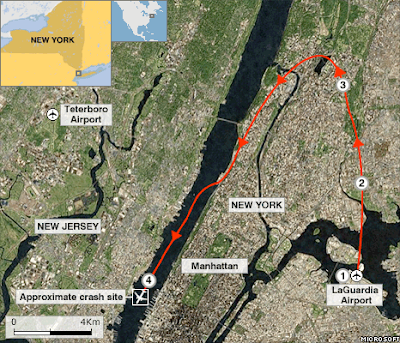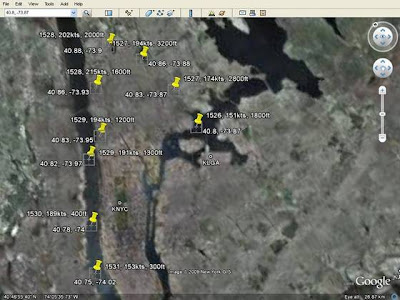Airbus Crashes in New York River – 16 January 2009
It’s the one-year anniversary of this crash. This was an emotive story, especially for those who fly regularly and have in the backs of their minds the fear of a crash - the difference with this crash being that all passengers and crew survived. How did the news media deal with this in terms of displaying the flight route and crash site?
I found the following two maps, one taken from the BBC News website and the other taken from the Huffington Post website. I know it may be unfair to compare a map placed on a website by one of the largest global media corporations with that of a small local paper. But I think this example illustrates how, with a bit of effort, a very bad map can be turned into a good one.
BBC News Map
Link to the story and map:
http://news.bbc.co.uk/2/hi/americas/7833025.stm

1 1526 local time (2026 GMT): Flight 1549 takes off from New York's LaGuardia Airport
2 1527 (2027 GMT): Pilot Chesley Sullenberger III reports birds hitting both engines and says he is returning to LaGuardia
3 1528 (2028 GMT): Plane banks to the left, but pilot decides he cannot reach LaGuardia or nearby Teterboro airport
4 1531 (2031 GMT): Pilot ditches plane in Hudson River
Good points about the map: the information is presented simply and clearly over the satellite image of the site, with the map placed in its geographical context in North America.
However, I assume that any cartographer looking at a map would have their own ideas of how to change or improve a map. In this map, I would include on the map itself some text about what happened at points 2 and 3.
Would the flight route have been better placed over a map of New York rather than a satellite image? I think the good thing about using imagery is that it is like a photograph and that a lot of what is displayed is understood intuitively, and does not require explanation. What strikes me about the image is that there is so little open space which could have been used to put that plane down safely. I don't think that would have come across as well using a map.
Huffington Post Map
Link to the story and map:
http://www.huffingtonpost.com/2009/01/15/hudson-river-plane-crash_n_158300.html

Why is it bad? In summary, lack of information and lack of summarizing what information was there for ease of comprehension by the viewer.
The image was not placed in a geographical context, so anyone not familiar with New York would have no idea where the crash happened.
No effort was made to indicate the direction of the flight, so that the viewer has to spend a few minutes working it out for themselves.
Joining the dots, or the place marks in this case, would have helped to show the flight rout more clearly.
KLGA and KNYC are incomprehensible labels for most people.
The cartographer (I use the term loosely here) did not bother to do more than a screen dump, and did not even make the effort to create a graphics file of the map alone.
The quality of the imagery used is very poor.
The GPS co-ordinates and altitude are surely of little or no interest to the general viewer and would constitute map crap, if there was anything else on the map.
HAITI EARTHQUAKE
Here's an interactive map, based on a satellite image, that shows the extent of damage in Port-au-Prince:
http://news.bbc.co.uk/2/hi/americas/8460787.stm
No comments:
Post a Comment